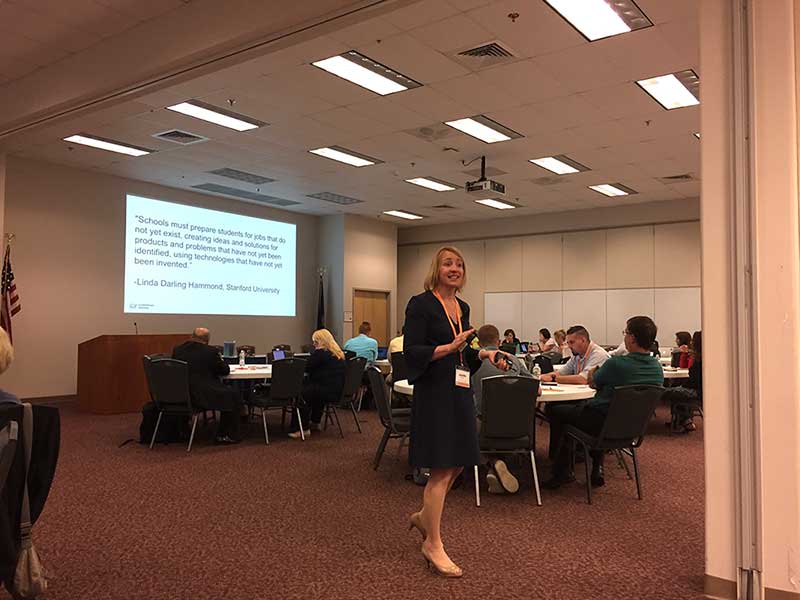Student Safety Symposium: Finding the Balance Between Access and Safety


At the Symposium on Student Safety in Lancaster, PA, a free event sponsored by Gaggle, school and district administrators, cabinet members, Intermediate Unit personnel, and other educators gathered for a half-day conversation on the topic of student online safety. The speakers included enough representatives from education, law, and government to have a well-rounded conversation on this broad topic.
The morning began with a keynote presentation from Common Sense Education’s Jennifer Ehehalt. “Digital citizenship is more than just compliance,” she said. “If you address digital citizenship as a standalone issue, it becomes ‘one more thing to do.’ You need to align digital citizenship with initiatives in place, such as social emotional learning.” The challenge for districts, she argued, was “trying to figure out how to walk the line between encouraging use of tech and safety.”
Next was a “Fireside Chat” with Gaggle’s Amber Aplington Johnson and Suzanne Fioravanti of Wayne Township District, who spoke about their experience using Gaggle in their district. She explained that they use Gaggle to monitor content and report any concerning email messages or documents and files in Google Drive. She stressed the importance of involving a variety of staff in this experience. “It can’t just be up to an assistant principal, for example,” she said. “You should include your safety/security staff, administrators, and local law enforcement, too.”
Now that the district’s students know the content they send or share using the school network is monitored, students are involved in keeping each other in check online. “One recent example was when a group of students were collaborating on a Google Document. One of the students was saying inappropriate things and his friends warned him: ‘Dude, the school is monitoring this, you should stop saying this.’ When the student continued to say inappropriate things, the other students started removing themselves from the shared document.”
The next presentation was from Nat Evans an Investigative Analyst from the Pennsylvania Internet Crimes Against (ICAC) Task Force. He talked about apps like Facebook “Stories”—Facebook’s version of Snapchat—and the many ways students think they get around leaving an incriminating digital footprint.
“Snapchat gives kids a false sense of security since the post disappears and they get notified if their post has been screen captured,” he said. “They don’t realize some students can still take pictures of the post with another device, and now Snapchat is starting to monitor their accounts.”
He offered this advice to children and adults: Think before you post, because you can’t take it back. “Students think that just because you delete a post, it’s gone. But, if someone has downloaded that post and put it onto a message board with a server in another country, there is nothing this agency or anyone else can do to delete it.” That damaging digital image will be on the Web forever, he said, and can easily be found by future colleges and employers. Students also don’t usually know that if a user is accused of a criminal activity, he said, their device can legally be confiscated, and searched—including technology that can find deleted content.
Tools and ideas to transform education. Sign up below.
He recommended schools reach out to their area ICAC Task Force representatives and invite them to come into their schools to talk to students, parents, and staff. He also mentioned resources like the www.cybertipline.com or 800-THE-LOST where people can anonymously report cyberbullying.
Evans then joined the closing panel, which included Paul Sanfrancesco (Owen J. Roberts School District), Charlie Reisinger (Penn Manor School District), and Erin D. Gilsbach (an attorney with King, Spry, Herman, Freund & Faul, and Director of Professional Education and Policy Development).
When asked about the challenge of getting parents to come out to digital education programs at school, Sanfrancesco recommended adding them to events that include other programs of interest. “To engage parents, host a community night, not just a ‘parent night.’ Have students teach parents how to use the apps like Snapchat, etc.” He also advised getting students involved in the programs as much as possible. "We need to educate teachers and principals, too, at every meeting about how to use tech in a positive way.”
Evans recommended mandating Internet safety training for parents as well as students before they are allowed to take home school-issued devices.
“We don’t see it as a tech problem,” Reisinger said. “It’s a communication problem. It should start with the relationships with the kids.”
The event concluded with an opportunity for each table to discuss takeaways from the event. Our table discussed the need for a broader-reaching approach to digital citizenship education. Many said their schools were still doing this as silo efforts, rather than integrating digital citizenship into everyday teaching and learning.
Attendees left with a wealth of resources to take back to their districts to address this important issue. Click here to access slides from Common Sense Education and here to access resources from the ICAC Task Force.
Christine Weiser is the Content and Brand Director for Tech & Learning, and has been with the company since 2008. She has reported on education for most of her career, working at Scholastic and Gale Publishing before joining Tech & Learning. Christine is also an author and musician, and lives in Philadelphia with her husband and son.
